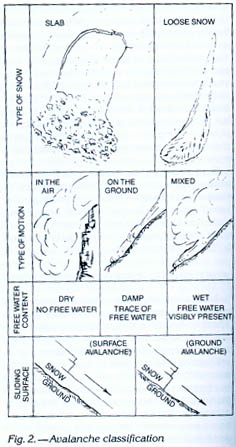The two main avalanches are loose
snow and slab avalanches. These two types of avalanches are distinguished
by the snow condition at the origin. However, sometimes classifications
must be modified on long avalanches, due to the fact that snow conditions
vary throughout the avalanche. All avalanches have a great potential
energy, that can be determined by their height and the force of an avalanche
is simply F= ma. This means that if a small avalanche contains 1000
kg of snow, it has a force of 9810 Newtons.
Loose snow avalanches usually start at a point or small area and expand as they move. They are a result of snow that has been deposited at a steeper angle then the snow’s natural angle of repose. The most dangerous loose snow avalanches are made of wet snow. This is because the wet snow is denser and has a greater destructive force even though the velocities may be low. The diagram shows the differences between loose snow and slab avalanches.
Loose snow avalanches usually start at a point or small area and expand as they move. They are a result of snow that has been deposited at a steeper angle then the snow’s natural angle of repose. The most dangerous loose snow avalanches are made of wet snow. This is because the wet snow is denser and has a greater destructive force even though the velocities may be low. The diagram shows the differences between loose snow and slab avalanches.

The ABC of Avalanche Safety
Slab avalanches are the most dangerous
type of avalanche. They are the largest source of winter hazards,
and most are triggered by the victims. Slab avalanches form in almost
all types of snow. Wind is an important factor to these avalanches,
because it causes and unstable slab. However, wind alone will not
cause a slab avalanche.
Gravity and the strength of the bonds between snow layers are important in slab avalanches. This is because gravity is the force which is pulling the slab down the mountain. When the force of gravity is greater than the bond between layers the gravity causes the top layer to separate and slide down the mountain.
The diagram below gives a good idea as to how a slab avalanche moves. It is easy to see how after the avalanche is triggered there is start zone, which moves down the "track" and finally ends in a debris toe. As the avalanche moves down the mountain kinetic energy increases while the potential energy decreases.
Gravity and the strength of the bonds between snow layers are important in slab avalanches. This is because gravity is the force which is pulling the slab down the mountain. When the force of gravity is greater than the bond between layers the gravity causes the top layer to separate and slide down the mountain.
The diagram below gives a good idea as to how a slab avalanche moves. It is easy to see how after the avalanche is triggered there is start zone, which moves down the "track" and finally ends in a debris toe. As the avalanche moves down the mountain kinetic energy increases while the potential energy decreases.

http://www.uoregon.edu/~opp/snow/avalanche/avalanchetypes.htm